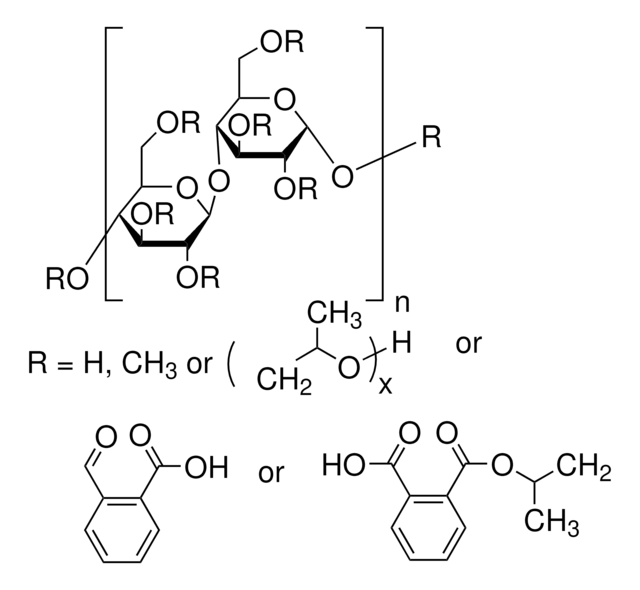09963
(Hydroxypropyl)methyl cellulose
Synonym(s):
2-Hydroxypropyl methyl cellulose ether
Sign Into View Organizational & Contract Pricing
All Photos(1)
About This Item
Recommended Products
form
powder
composition
hydroxylpropoxyl content, ~9%
color
faint beige
viscosity
~15 mPa.s, 2 % in H2O(25 °C)
solubility
water: 100 mg/10 mL, clear, colorless
storage temp.
room temp
Looking for similar products? Visit Product Comparison Guide
Application
(Hydroxypropyl)methyl cellulose (HPMC), an inert viscoelastic polymer is used as an emulsifier, thickening and suspending agent similar to animal gelatin. HPMC is used in the development of controlled-delivery medicament.
Thickener for aqueous and non-aqueous systems, clear films with grease resistance, binders, lubricants, steric stabilizer and water retention aid.
Features and Benefits
Dissolves in water, undergoes reversible gelation upon heating, non-ionic, does not complex with ionic species and is surface active and enzyme resistant. Solutions are pseudoplastic.
Other Notes
To gain a comprehensive understanding of our extensive range of Polysaccharides for your research, we encourage you to visit our Carbohydrates Category page.
Storage Class Code
11 - Combustible Solids
WGK
WGK 1
Flash Point(F)
Not applicable
Flash Point(C)
Not applicable
Personal Protective Equipment
dust mask type N95 (US), Eyeshields, Gloves
Certificates of Analysis (COA)
Search for Certificates of Analysis (COA) by entering the products Lot/Batch Number. Lot and Batch Numbers can be found on a product’s label following the words ‘Lot’ or ‘Batch’.
Already Own This Product?
Find documentation for the products that you have recently purchased in the Document Library.
Customers Also Viewed
Punit P Shah et al.
Biomaterials, 33(5), 1607-1617 (2011-11-29)
The aim of this study was to develop an effective drug delivery system for the simultaneous topical delivery of two anti-inflammatory drugs, spantide II (SP) and ketoprofen (KP). To achieve this primary goal, we have developed a skin permeating nanogel
Lucas Sievens-Figueroa et al.
International journal of pharmaceutics, 423(2), 496-508 (2011-12-20)
The design and feasibility of a simple process of incorporating stable nanoparticles into edible polymer films is demonstrated with the goal of enhancing the dissolution rate of poorly water soluble drugs. Nanosuspensions produced from wet stirred media milling (WSMM) were
Michelle Lay Teng Ang et al.
Infection and immunity, 82(5), 1850-1859 (2014-02-26)
Tuberculosis remains a major worldwide epidemic because of its sole etiological agent, Mycobacterium tuberculosis. Ethionamide (ETH) is one of the major antitubercular drugs used to treat infections with multidrug-resistant M. tuberculosis strains. ETH is a prodrug that requires activation within
A Akbarian et al.
Poultry science, 93(8), 1930-1941 (2014-06-17)
Heat stress in poultry is a serious problem in many countries and has been associated with oxidative stress. Hence, nutritional interventions with antioxidants might be beneficial. Therefore, the effects of dietary Curcuma xanthorrhiza (CX) and Origanum compactum (OC) essential oils
Jeonghoon Han et al.
Aquatic toxicology (Amsterdam, Netherlands), 152, 308-317 (2014-05-13)
In this study, we investigated the effects of the water-accommodated fraction (WAF) of crude oil on the development and reproduction of the intertidal copepod Tigriopus japonicus through life-cycle experiments. Furthermore, we investigated the mechanisms underlying the toxic effects of WAF
Our team of scientists has experience in all areas of research including Life Science, Material Science, Chemical Synthesis, Chromatography, Analytical and many others.
Contact Technical Service





